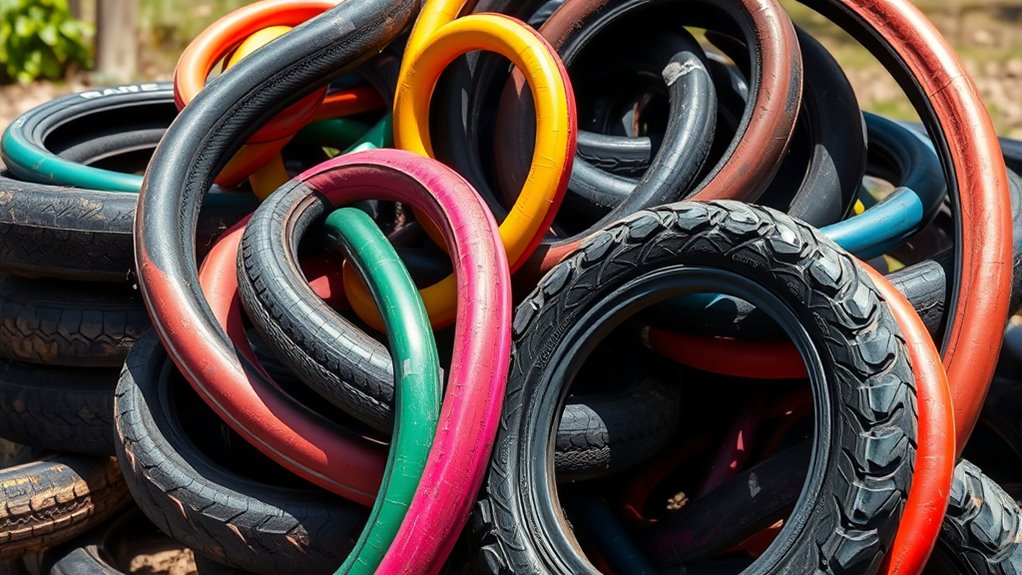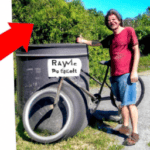Recycling inner tubes and tires helps you reduce waste and protect the environment by repurposing discarded materials into useful and creative items. You can transform tires into garden planters or outdoor furniture, while inner tubes make stylish wallets, belts, or art pieces. These materials are durable, versatile, and easy to customize with simple tools. Keep exploring, and you’ll discover more ways to turn old tires and tubes into eco-friendly projects that benefit your community.
Key Takeaways
- Inner tubes and tires can be recycled through specialized facilities that process rubber for new products.
- Many communities offer tire and rubber recycling programs or drop-off centers.
- Recycling prevents environmental pollution by reducing landfill waste and harmful emissions.
- Some manufacturers accept old tires and inner tubes for reuse or remanufacturing.
- Upcycling projects provide an eco-friendly alternative to traditional recycling, turning waste into useful items.

Have you ever wondered what happens to old inner tubes and tires once they’re no longer useful? Many of us simply toss them in the trash, but that’s a missed opportunity. Instead, you can turn these discarded items into something new and functional through upcycling projects. Upcycling not only gives new life to worn-out materials but also helps reduce waste that ends up in landfills. This approach offers significant environmental benefits because it minimizes the need for raw materials, conserves energy, and decreases pollution.
Turning old tires into eco-friendly creations reduces waste and benefits the planet.
By upcycling inner tubes and tires, you take an eco-friendly route that benefits the planet. These materials are durable and versatile, making them perfect for creative projects. For example, old tires can be transformed into garden planters, outdoor furniture, or even playground equipment. Inner tubes are equally adaptable—they can be turned into stylish wallets, belts, or unique art pieces. When you choose to upcycle, you help divert waste from the environment and reduce the demand for new resources, which in turn cuts down on the harmful emissions associated with manufacturing and disposal.
Getting involved in upcycling projects is easier than you might think. You don’t need special skills—just a bit of creativity and some basic tools. Start by cleaning the tires or inner tubes thoroughly, removing any debris or residue. Then, with simple cutting, sewing, or painting, you can customize your items to fit your style or needs. For example, a used inner tube can become a sturdy, waterproof bag with just some sewing and reinforcement. This process not only saves money but also provides a sense of satisfaction, knowing you’re contributing to a healthier environment.
Additionally, understanding the properties of materials like high durability and their ability to be repurposed makes upcycling even more valuable. Beyond individual benefits, your participation in upcycling projects encourages others to think differently about waste. It promotes a circular mindset that values reuse and sustainability. As more people get involved, the cumulative environmental benefits grow—less landfill waste, reduced pollution, and a smaller carbon footprint. Plus, upcycling often sparks community connections and inspires innovative ideas for repurposing other discarded materials.
In the end, choosing to upcycle inner tubes and tires isn’t just about saving money or making cool crafts—it’s a conscious decision to protect the environment. Every project you undertake helps reduce waste and promotes a sustainable lifestyle. So next time you see an old tire or inner tube, consider how you can give it a second chance. Your small effort can make a big difference in creating a cleaner, greener world.
Frequently Asked Questions
Are There Any Hazardous Chemicals in Recycled Tires?
Yes, recycled tires can contain hazardous chemicals, so chemical safety is important. Some toxic components, like heavy metals and certain sulfur compounds, may be present due to the manufacturing process. These chemicals can pose health risks if not handled properly. When recycling or repurposing tires, guarantee proper safety measures to avoid exposure to toxic components, and follow guidelines to minimize environmental impact and protect your health.
How Long Does It Take for Tires to Decompose Naturally?
Tires take about 50 to 80 years to biodegrade naturally, depending on environmental conditions. During this biodegradation timeline, they slowly break down, but their rubber and chemicals can persist, posing significant environmental impact. You should understand that this slow process means tires can accumulate in landfills, releasing harmful substances over time. Reducing tire waste and recycling can help mitigate their environmental footprint and lessen long-term ecological harm.
Can Recycled Inner Tubes Be Used for DIY Crafts?
Recycled inner tubes are like a blank canvas for your creativity, making them perfect for DIY crafts. You can turn them into unique inner tube crafts like wallets, bags, or even furniture. These projects are sustainable and cost-effective, giving new life to materials that would otherwise be discarded. With a little effort, your DIY tire projects can be both functional and artistic, showcasing your eco-friendly spirit and craft skills.
What Are the Environmental Benefits of Recycling Tires?
Recycling tires benefits the environment by reducing waste and conserving resources. When you recycle tire rubber through proper recycling processes, it prevents tires from ending up in landfills, where they take centuries to decompose. Recycling tires also minimizes the need for virgin rubber production, cutting down on energy use and pollution. By choosing to recycle, you help lower greenhouse gas emissions and support sustainable practices that protect our planet.
Are There Specific Disposal Regulations for Tire Recycling?
Think of tire disposal regulations like a recipe you must follow carefully. You need to meet specific recycling compliance standards to avoid penalties and protect the environment. Regulations vary by region, so you should check local laws about tire disposal regulations. Properly adhering to these rules guarantees safe and eco-friendly recycling, preventing illegal dumping and reducing pollution. Staying informed helps you become a responsible recycler and keeps your community cleaner.
Conclusion
Just like a skilled gardener turning old, tired soil into rich earth, you have the power to transform discarded tires and inner tubes into something new and useful. By recycling, you’re planting seeds of change, helping the environment flourish. Every tire you reuse is a drop of water nourishing our planet’s future. So, embrace this eco-friendly journey—your actions today will bloom into a healthier, greener tomorrow.















